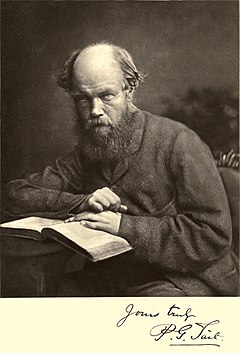Peter Guthrie Tait
| Peter Guthrie Tait | |
|---|---|

Peter Guthrie Tait – Scottish physicist, an early pioneer in thermodynamics
|
|
| Born |
28 April 1831 Dalkeith |
| Died |
4 July 1901 (aged 70) Edinburgh |
| Residence | United Kingdom of Great Britain and Ireland |
| Citizenship | British |
| Nationality | Scottish |
| Fields | Mathematical physics |
| Institutions | Peterhouse, Cambridge |
| Alma mater |
University of Edinburgh Peterhouse, Cambridge |
| Academic advisors | William Hopkins |
| Notable awards |
Smith's Prize (1852) Royal Medal (1886) |
Peter Guthrie Tait FRSE (28 April 1831 – 4 July 1901) was a Scottish mathematical physicist, best known for the mathematical physics textbook Treatise on Natural Philosophy, which he co-wrote with Kelvin, and his early investigations into knot theory, which contributed to the eventual formation of topology as a mathematical discipline. His name is known in graph theory mainly for Tait's conjecture.
He was born in Dalkeith. After attending the Edinburgh Academy and University of Edinburgh, he went up to Peterhouse, Cambridge, graduating as senior wrangler and first Smith's prizeman in 1852. As a fellow and lecturer of his college he remained in Cambridge for two years longer, and then left to take up the professorship of mathematics at Queen's College, Belfast. There he made the acquaintance of Thomas Andrews, whom he joined in researches on the density of ozone and the action of the electric discharge on oxygen and other gases, and by whom he was introduced to Sir William Rowan Hamilton and quaternions.
In 1860, Tait succeeded his old master, James D. Forbes, as professor of natural philosophy at Edinburgh, and occupied that chair until shortly before his death. The first scientific paper under Tait's name only was published in 1860. His earliest work dealt mainly with mathematical subjects, and especially with quaternions, which he was the leading exponent of after their originator, Hamilton. He was the author of two text-books on them—one an Elementary Treatise on Quaternions (1867), written with the advice of Hamilton, though not published till after his death, and the other an Introduction to Quaternions (1873), in which he was aided by Philip Kelland (1808–1879), one of his teachers at Edinburgh. Quaternions was also one of the themes of his address as president of the mathematical section of the British Association for the Advancement of Science in 1871.
...
Wikipedia
